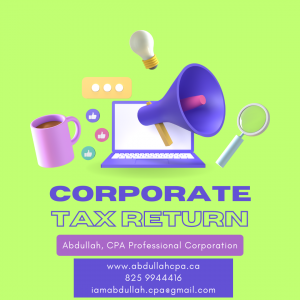Just in case this is the first post of mine you’re reading, a little introduction is called for. I’m Abdullah, a chartered professional accountant and tax expert in the Mississauga and Toronto regions of Ontario, Canada. This article is about converting a sole proprietorship to a corporation.
Why?
So, why should you change to a corporation in the first place? There are three main reasons, and they are:
1. A corporation presents you with limited liability protection. What this means is that if you are sued then the only assets that are at risk in the lawsuit are the corporation’s assets, not your personal assets. On the other hand, if you remain with sole proprietorship, meaning you’re non-incorporated, and you get sued, your personal assets are at risk as well as your business assets. So, you could lose your home, your car, your investments, and so forth. This is something that you want to avoid altogether.
2. The second reason for changing into a corporation is the tax rate for a corporation is lower than the tax rate for an individual. The corporate tax rate combines the provincial and federal, and in the province of Ontario it’s only 15.5% for the first $500,000 of business profits. Business income, at the individual level, is taxed at marginal tax rates. The marginal tax rate at the top bracket in the province of Ontario is 46.4%. You can see that you will save approximately 31% if you incorporate. That’s 31% in taxes on your business income.
3. The third reason for changing into a corporation is with a corporation it’s a lot easier to split business income with your family members through the use of dividends.
Closing the Sole Proprietorship:
How do you close your sole proprietorship if you have one right now? Well, you have to do two things.
• You need to cancel your business registration with the Ontario Ministry of Governmental Services. If you live in another province, get in touch with the Ministry of Governmental Services, and similar procedures will apply.
• The second thing you need to do is contact the Canada Revenue Agency at 1-800-959-5525. Cancel your business number, HST number, and payroll number, if you have them, with the Canada Revenue Agency; and you should be able to do this over the phone.
Transferring of Assets:
The third thing we talk about is what assets are transferred from proprietorship to a corporation when you form your new corporation. Well, there are two categories of assets.
- 1. The first category is physical assets. Examples include equipment, computers, vehicles, furniture, and so forth.
- Vehicles can also be transferred to the corporation but there must be an ownership change to the corporation which has to be done at the ministry of transportation office. The transfer will be exempted from tax as long as the owner of the newly formed corporation is the same owner of the vehicle while controlling the sole proprietorship. In order to claim this exemption you must fill out the forms “Sworn Statement for the Transfer of a Used Vehicle in the Province of Ontario” and the Addendum to Sworn Statement when Claiming an Exempt Transfer of Used Vehicles between Corporations, or Corporations and Shareholders”. Insurance must also be registered to the corporation.
2. The second category in intangible assets; and you may not think about it but one of the biggest assets for your business is an intangible one, and that is goodwill. Goodwill, by definition, is what someone would pay for your business over the cost or price of the physical assets. So it is simply viewed as the approximate value of a company’s brand names, reputation, or long-term relationships that cannot otherwise be represented financially.
The Value of the Goodwill
Since goodwill is an intangible asset, it is difficult to accurately quantify since it differs in its composition and varies from industry to industry and businesses.
Goodwill is the difference between the tangible assets and the purchase price.
The total value of any business can be described as the accumulative sum of its physical tangible assets plus the value of its goodwill. So goodwill is essentially equal to the difference between the total value minus the standalone value of its tangible physical assets.
If a company is sold for $5 million, but only had $3 million in tangible physical assets then we would equate its goodwill to $2 million.
Some common goodwill items include: phantom assets, local economy, loyal customer base, reputation, supplier list, location, trademarks, name recognition, copyrights, trade secrets, industry ratios, royalty agreements, licenses, contracts, growing industry, and recession resistant industry.
Workplace Safety and Insurance Board (WSIB) Account
In most cases, your corporation should assume the liabilities and assets of your sole proprietorship when you transfer your assets. Your previous WSIB account will also be assumed by your corporation. If this is not the case, you will have to open up a new account.
The Section 85 Rollover:
It’s really important for you to get this right because this could save you a lot of money. When you are transferring assets from your proprietorship to your corporation, you should do so only under the provision of Section 85 of the Income Tax Act. You have to do this and you have to file the related Section 85 forms. By doing so, you will not have to pay any tax on the sale of your assets, both, physical and intangible, from your sole proprietorship to your corporation.
If you don’t file Section 85 rollover, either because you didn’t know, or because you didn’t want to go through the tough exercise of doing so, you’re in for a surprise. What will end up happening is that the CRA will reassess the transaction and bump up the sale price to the fair market value of the assets. Here’s an example.
If the assets that you own, including goodwill, are a hundred thousand dollars, and you paid only thirty thousand dollars for them, then the CRA will impose capital gains tax on the gain of seventy thousand dollars. This will happen only if you do not file an election pursuant to Section 85 of the Income Tax Act to transfer your assets from your sole proprietorship to your corporation.
Pitfalls to Avoid:
In converting a sole proprietorship to a corporation there are certain pitfalls you’d need to avoid. These pitfalls have come from mistakes I’ve seen others make and I’m going to share them here. The first main mistake I’ve seen people make is that they sell their assets for only a dollar; that is, they sell their business assets to their corporation for only $1. Now, if you are ready to sell your business assets to me for a dollar I’d readily buy them. The CRA does not like this and what they’ll do is reassess the sale price from one dollar to the fair market value (that’s what a third party would pay). As a result you end up paying capital gains tax on the difference between the fair market value of the assets transferred and what you paid for them.
The second major mistake that I’ve seen people make throughout my career is that they gift assets to the corporation they just formed. What this means is that are transferring the assets from their sole proprietorship to their new corporation without receiving any consideration like money or shares in return for the transfer. If you do that, once again, the CRA will step in, reassess the sale price from zero to what the fair market value of the assets is, and you will end up paying capital gains tax on the difference between the fair market value of the assets transferred and what you paid for them.
Here’s hoping that what you read here about converting a sole proprietorship to a corporation you found useful, and know that you can get more such advice for free just as long as you know where to look (and now you do).
Get in Touch with Abdullah CPA to convert your Sole propritership to a Corporation and Save Significants taxes.






